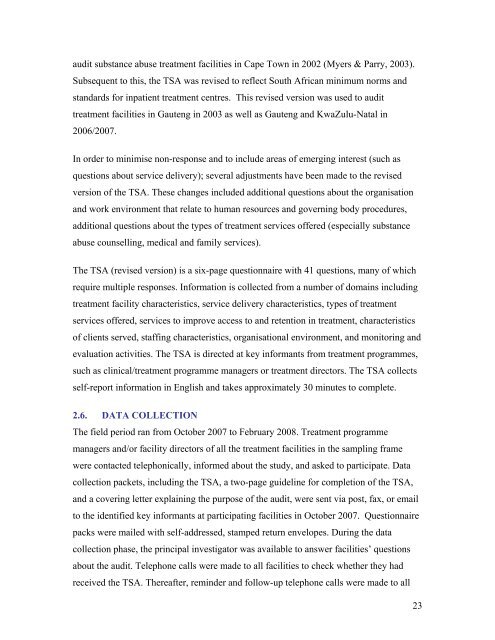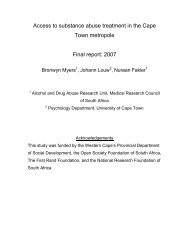Audit of Substance Abuse Treatment Facilities in ... - SA HealthInfo
Audit of Substance Abuse Treatment Facilities in ... - SA HealthInfo
Audit of Substance Abuse Treatment Facilities in ... - SA HealthInfo
- No tags were found...
Create successful ePaper yourself
Turn your PDF publications into a flip-book with our unique Google optimized e-Paper software.
audit substance abuse treatment facilities <strong>in</strong> Cape Town <strong>in</strong> 2002 (Myers & Parry, 2003).Subsequent to this, the T<strong>SA</strong> was revised to reflect South African m<strong>in</strong>imum norms andstandards for <strong>in</strong>patient treatment centres. This revised version was used to audittreatment facilities <strong>in</strong> Gauteng <strong>in</strong> 2003 as well as Gauteng and KwaZulu-Natal <strong>in</strong>2006/2007.In order to m<strong>in</strong>imise non-response and to <strong>in</strong>clude areas <strong>of</strong> emerg<strong>in</strong>g <strong>in</strong>terest (such asquestions about service delivery); several adjustments have been made to the revisedversion <strong>of</strong> the T<strong>SA</strong>. These changes <strong>in</strong>cluded additional questions about the organisationand work environment that relate to human resources and govern<strong>in</strong>g body procedures,additional questions about the types <strong>of</strong> treatment services <strong>of</strong>fered (especially substanceabuse counsell<strong>in</strong>g, medical and family services).The T<strong>SA</strong> (revised version) is a six-page questionnaire with 41 questions, many <strong>of</strong> whichrequire multiple responses. Information is collected from a number <strong>of</strong> doma<strong>in</strong>s <strong>in</strong>clud<strong>in</strong>gtreatment facility characteristics, service delivery characteristics, types <strong>of</strong> treatmentservices <strong>of</strong>fered, services to improve access to and retention <strong>in</strong> treatment, characteristics<strong>of</strong> clients served, staff<strong>in</strong>g characteristics, organisational environment, and monitor<strong>in</strong>g andevaluation activities. The T<strong>SA</strong> is directed at key <strong>in</strong>formants from treatment programmes,such as cl<strong>in</strong>ical/treatment programme managers or treatment directors. The T<strong>SA</strong> collectsself-report <strong>in</strong>formation <strong>in</strong> English and takes approximately 30 m<strong>in</strong>utes to complete.2.6. DATA COLLECTIONThe field period ran from October 2007 to February 2008. <strong>Treatment</strong> programmemanagers and/or facility directors <strong>of</strong> all the treatment facilities <strong>in</strong> the sampl<strong>in</strong>g framewere contacted telephonically, <strong>in</strong>formed about the study, and asked to participate. Datacollection packets, <strong>in</strong>clud<strong>in</strong>g the T<strong>SA</strong>, a two-page guidel<strong>in</strong>e for completion <strong>of</strong> the T<strong>SA</strong>,and a cover<strong>in</strong>g letter expla<strong>in</strong><strong>in</strong>g the purpose <strong>of</strong> the audit, were sent via post, fax, or emailto the identified key <strong>in</strong>formants at participat<strong>in</strong>g facilities <strong>in</strong> October 2007. Questionnairepacks were mailed with self-addressed, stamped return envelopes. Dur<strong>in</strong>g the datacollection phase, the pr<strong>in</strong>cipal <strong>in</strong>vestigator was available to answer facilities’ questionsabout the audit. Telephone calls were made to all facilities to check whether they hadreceived the T<strong>SA</strong>. Thereafter, rem<strong>in</strong>der and follow-up telephone calls were made to all23
















